Table of Contents
- Introduction
- Editor’s Choice
- Digital Remittance Market Overview
- Global Remittance Volume
- World’s Top Remittance Recipient Nations
- Transaction Value of Digital Remittances
- Number of Digital Remittance Users and Penetration Rate
- Average Transaction Value Per User
- Share of Digitally Initiated Remittances Across the World
- Digital Remittance Transaction Value Across Various Nations
- Digital Remittance Growth and Transaction Values by Region
- Adoption Trends in Digital Remittance
- Use of Digital Financial Technology During the COVID-19 Pandemic
- Key Challenges in Digital Remittance
Introduction
According to Digital Remittance Statistics, Digital remittance, facilitated through online platforms and mobile apps, involves the electronic transfer of funds across borders.
It offers individuals the convenience of sending money internationally to family, friends, or businesses in different countries.
With its speed and lower costs compared to traditional methods, digital remittance has become increasingly popular among migrants and expatriates.
Providers comply with regulatory requirements and employ measures like identity verification to ensure security.
Users can fund transactions through various payment gateway options, and recipients may receive funds directly into their bank accounts or through cash pickup locations.
Overall, digital remittance has transformed international money transfers, providing a fast, affordable, and convenient solution for individuals with global financial needs.
Editor’s Choice
- The global digital remittance market revenue reached USD 22.1 billion in 2023.
- Among the competitive landscape, Azimo Limited leads the market with a significant share of 19%.
- The global digital remittance market is regionally segmented, with North America leading the way with a 32.0% market share.
- By 2023, the total remittance volume had reached USD 750 billion, with digital remittances at USD 387 billion and non-digital volume at USD 363 billion.
- By 2028, the transaction value of digital remittances is projected to be USD 181.6 billion.
- The United States leads the market with a digital remittance transaction value of USD 29,920 million.
- A study in France and Poland found that 62% to 67% of individuals used digital devices for international P2P remittances, compared to 61% in the United States, where physical payments like cash and cheques remain common.
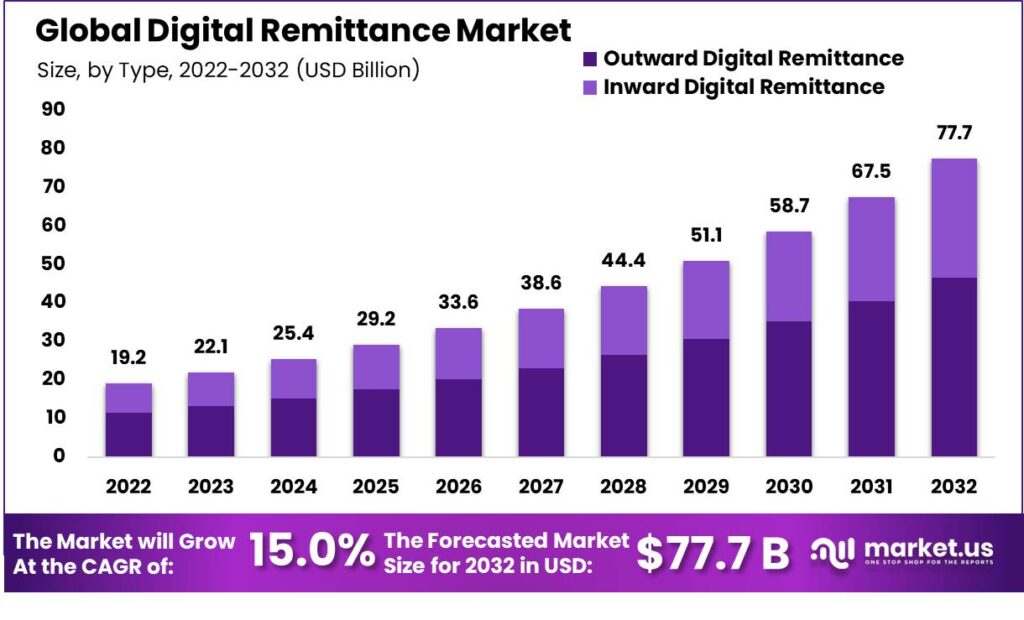
Digital Remittance Market Overview
Global Digital Remittance Market Size
- The global digital remittance market has experienced significant growth over the past decade at a CAGR of 15.0%.
- In 2022, the market revenue was valued at USD 19.2 billion. This figure rose to USD 22.1 billion in 2023 and is projected to continue its upward trajectory.
- The market is anticipated to continue expanding, with a projected revenue of USD 67.5 billion in 2031 and USD 77.7 billion by 2032.

Global Digital Remittance Market Size – By Type
- The global digital remittance market has demonstrated substantial growth, with a detailed breakdown by type revealing distinct trends in outward and inward digital remittance revenues.
- In 2022, the total market revenue was USD 19.2 billion, with outward digital remittance contributing USD 11.5 billion and inward digital remittance contributing USD 7.7 billion.
- The upward trend is expected to persist, with 2030 projections at USD 58.7 billion (USD 35.2 billion outward, USD 23.5 billion inward), 2031 at USD 67.5 billion (USD 40.5 billion outward, USD 27.0 billion inward), and 2032 at USD 77.7 billion (USD 46.6 billion outward, USD 31.1 billion inward).

Competitive Landscape of Global Digital Remittance Market
- The digital remittance market is characterized by the presence of several key players, each holding varying shares of the market.
- Azimo Limited leads the market with a significant share of 19%, followed by InstaReM Pvt. Ltd. with a 17% market share.
- Digital Wallet Corporation holds 13% of the market, while TransferGo Ltd. accounts for 10%.
- Both MoneyGram and TransferWise Ltd. each capture 8% of the market.
- PayPal Holdings, Inc. has a 7% market share, and Western Union Holdings, Inc. holds 6%.
- Ria Financial Services Ltd. contributes 5% to the market.
- The remaining 8% of the market is distributed among other key players.

Regional Analysis of the Global Digital Remittance Market
- The global digital remittance market is regionally segmented, with North America leading the way with a 32.0% market share.
- Europe follows closely with 26.3%, while the Asia-Pacific (APAC) region holds a substantial 28.9% share.
- South America accounts for 9.1% of the market, and the Middle East and Africa (MEA) region represents 3.7%.
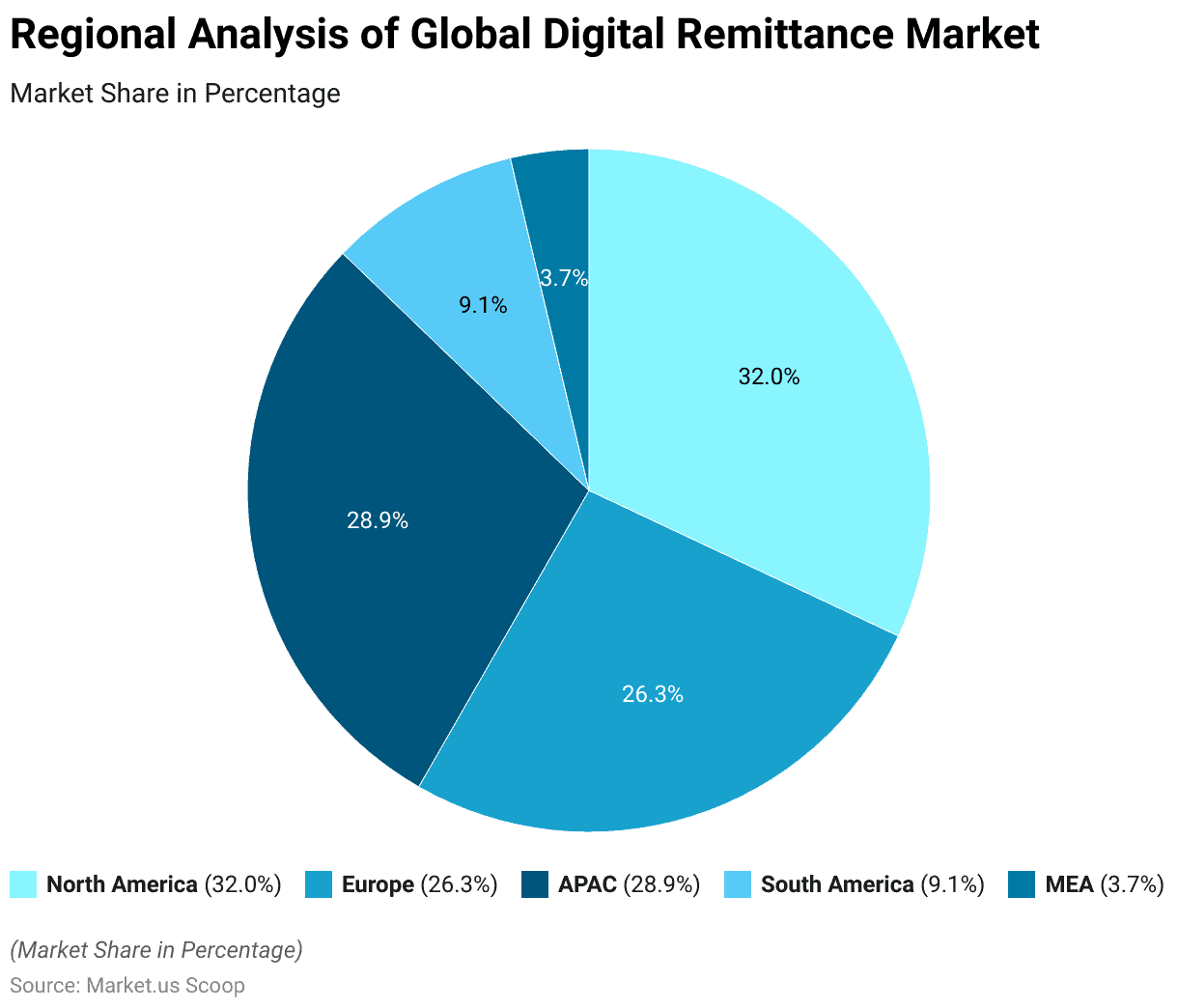
Global Remittance Volume
- The global remittance volume has shown a steady increase over the past decade, with a significant shift towards digital remittance services.
- In 2014, the total remittance volume was USD 598 billion, of which USD 538 billion was non-digital, and USD 60 billion was digital.
- By 2023, the total remittance volume had reached USD 750 billion, with digital remittances at USD 387 billion and non-digital volume at USD 363 billion.
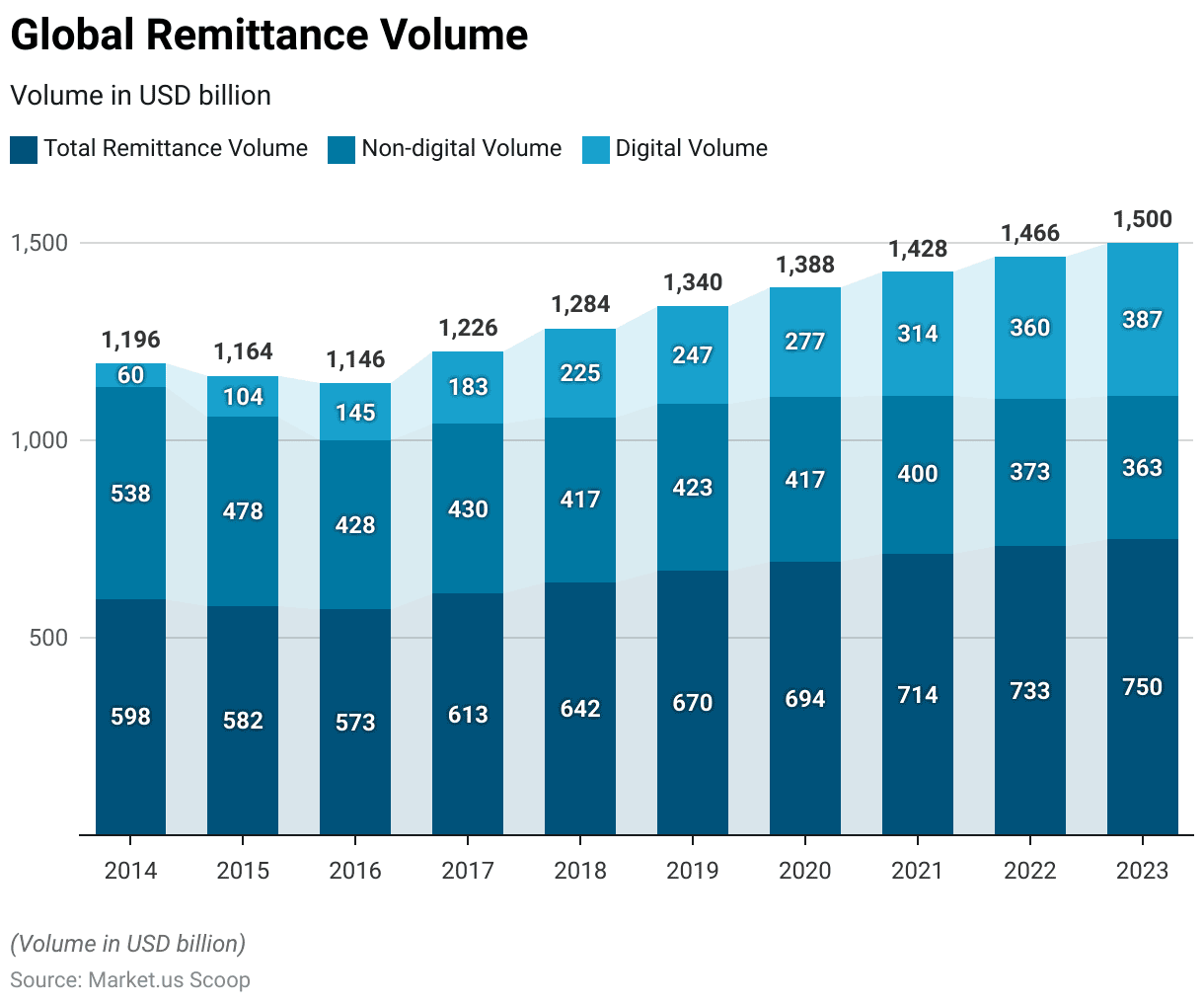
World’s Top Remittance Recipient Nations
- In 2020, the top ten remittance-receiving nations experienced varying degrees of change compared to 2019, reflecting diverse economic impacts and migration patterns.
- India remained the largest recipient with USD 83.1 billion in remittances, experiencing a slight decrease of 0.2% from the previous year.
- China received USD 59.5 billion, marking a significant decline of 13%.
- Mexico saw a robust increase of 9.9%, receiving USD 42.9 billion.
- The Philippines received USD 34.9 billion, a slight decrease of 0.7%.
- Egypt experienced a substantial increase of 10.5%, with remittances totaling USD 29.6 billion.
- Pakistan recorded a notable rise of 17.4%, reaching USD 26.1 billion.
- France saw a decline of 8.8%, with USD 24.5 billion in remittances.
- Bangladesh reported an impressive 18.4% increase, receiving USD 21.8 billion.
- Germany experienced a 2% decline, with remittances totaling USD 17.9 billion.
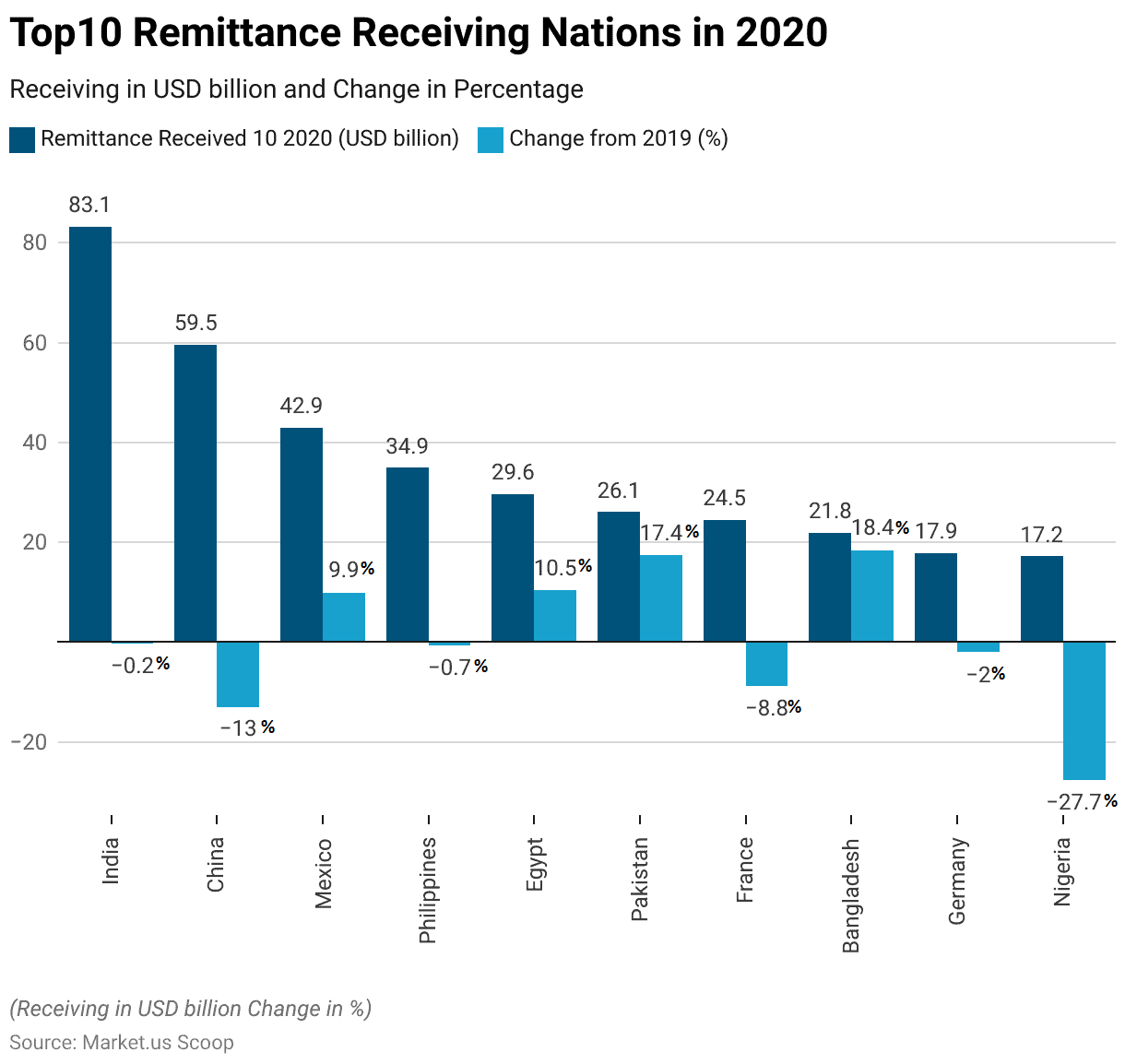
Transaction Value of Digital Remittances
- The transaction value of digital remittances has shown a consistent upward trend over the past decade, indicating the growing adoption of digital remittance services.
- In 2018, the transaction value stood at USD 68.88 billion.
- By 2027, the transaction value is anticipated to reach USD 176.5 billion, and by 2028, it is projected to be USD 181.6 billion.
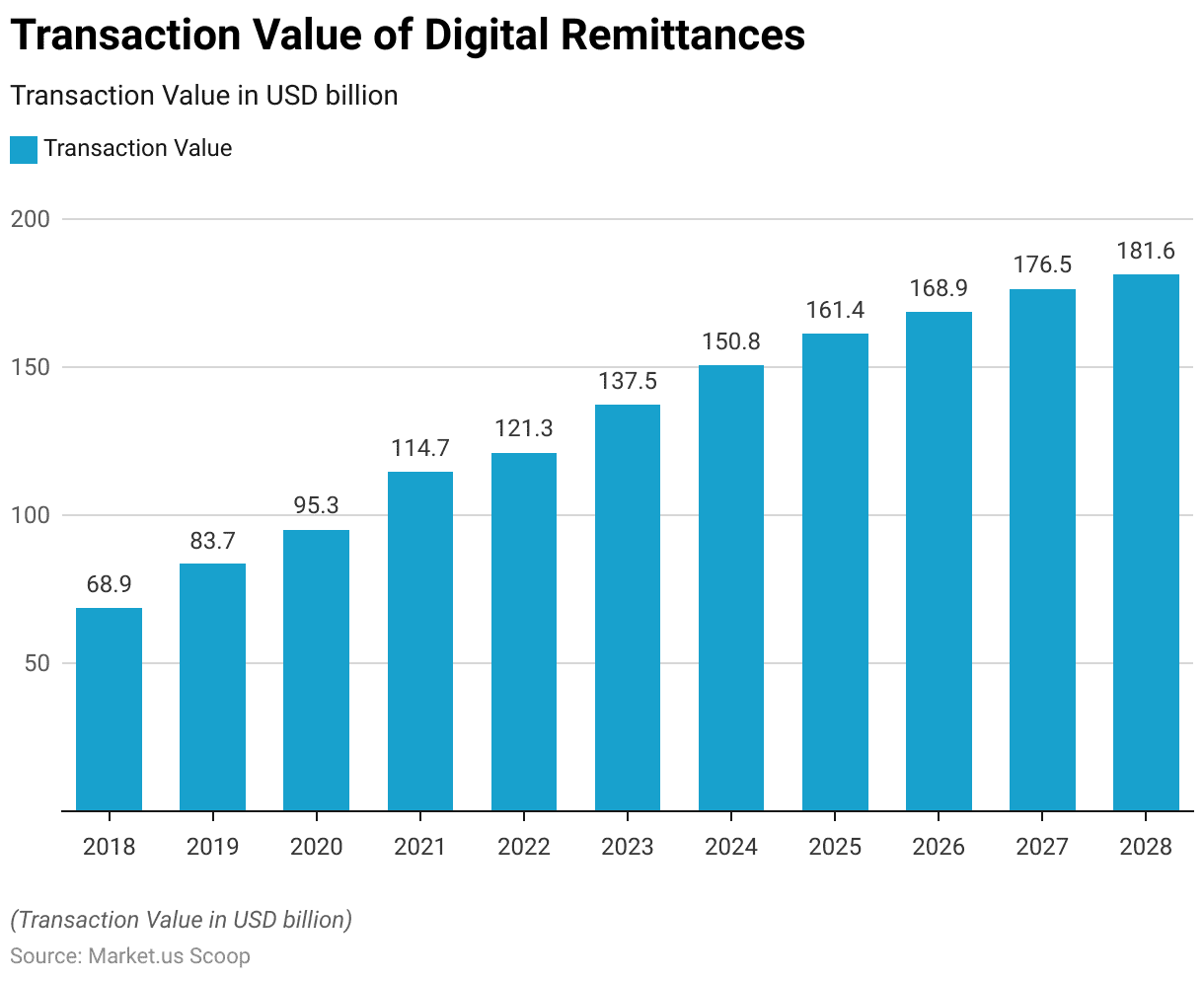
Change in Transaction Value
- The digital remittance market has experienced varying rates of transaction value change over the past decade, reflecting fluctuating growth dynamics.
- In 2018, the transaction value change was notably high at 23.30%, followed by a slight decrease to 21.56% in 2019.
- By 2028, the transaction value change is projected to further decrease to 2.86%.
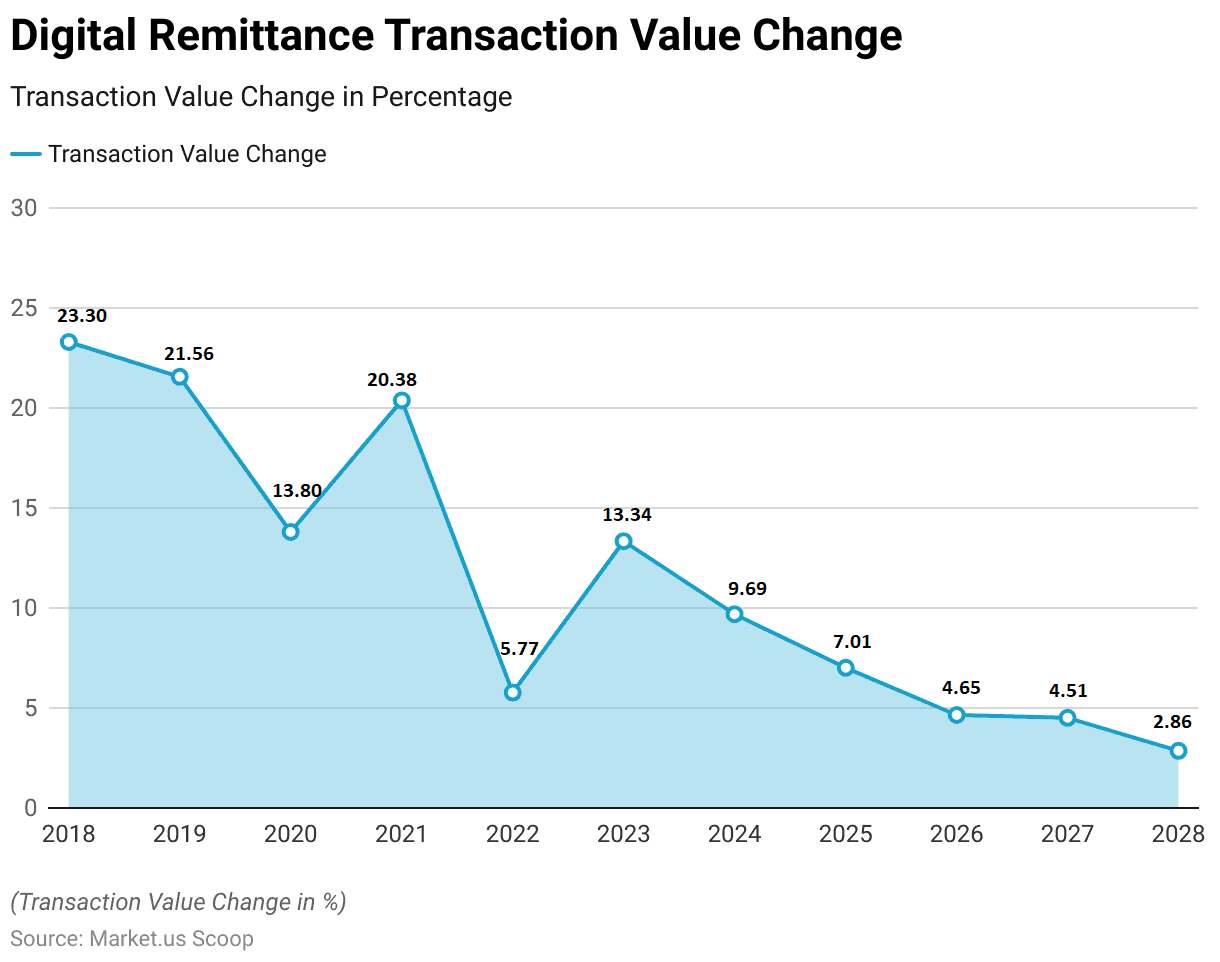
Number of Digital Remittance Users and Penetration Rate
- The number of digital remittance users has been steadily increasing, accompanied by a gradual rise in the penetration rate.
- In 2018, there were 6.37 million digital remittance users, representing a penetration rate of 0.09%. This number grew to 7.72 million users in 2019, with a penetration rate of 0.10%.
- The trend continued in 2020, with 9.30 million users and a penetration rate of 0.13%.
- The number of digital remittance users is expected to reach 18.46 million in 2027, with a penetration rate of 0.24%. By 2028, it is forecasted to increase to 18.74 million users slightly, maintaining a penetration rate of 0.24%.
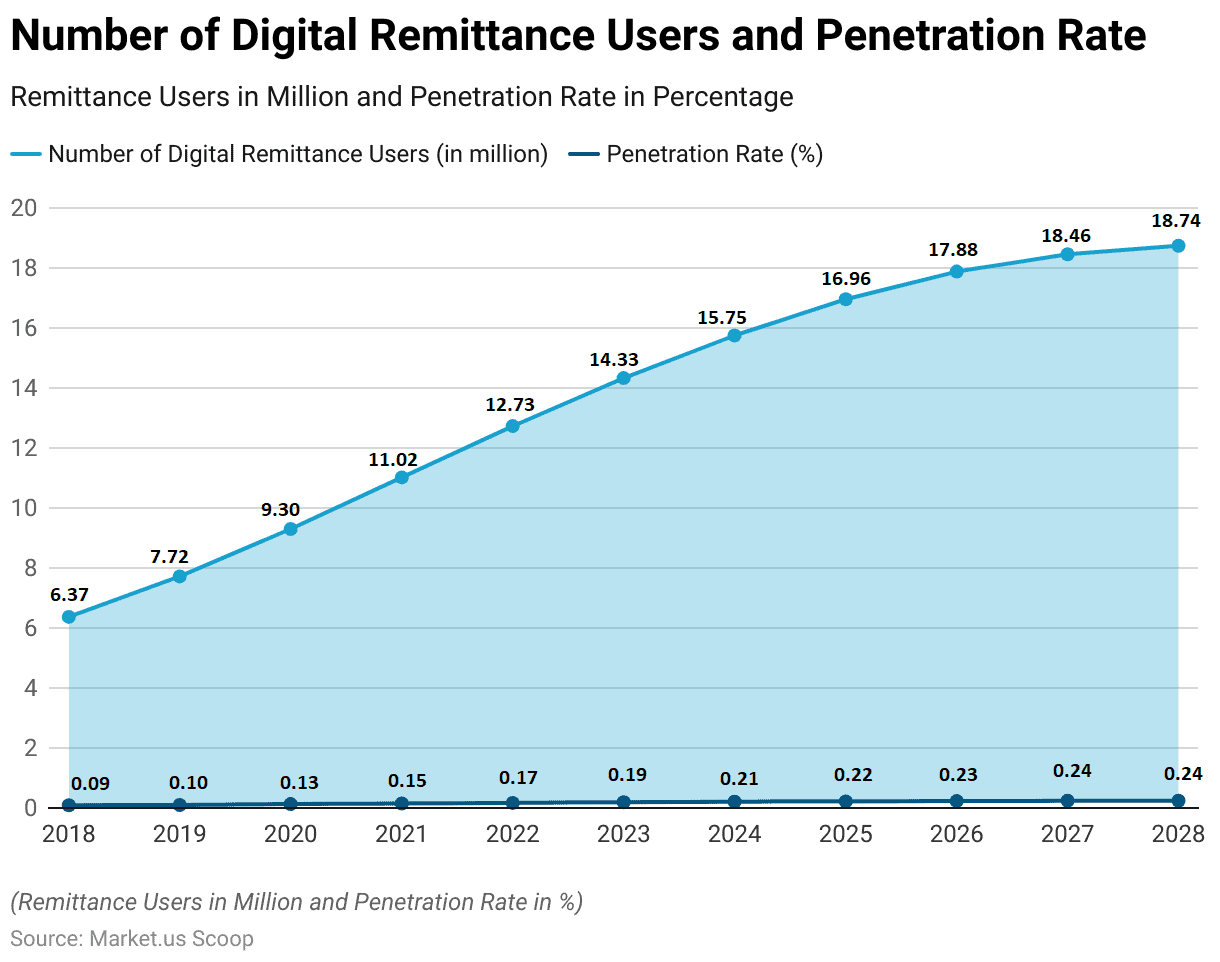
Average Transaction Value Per User
- The average transaction value per user in the digital remittance market has exhibited slight fluctuations over the past decade.
- In 2018, the average transaction value per user was USD 10.81, which saw a marginal increase to USD 10.84 in 2019.
- However, in 2020, there was a decrease to USD 10.24.
- By 2027, a slight increase to USD 9.56 is anticipated, with a further increase to USD 9.69 expected in 2028.
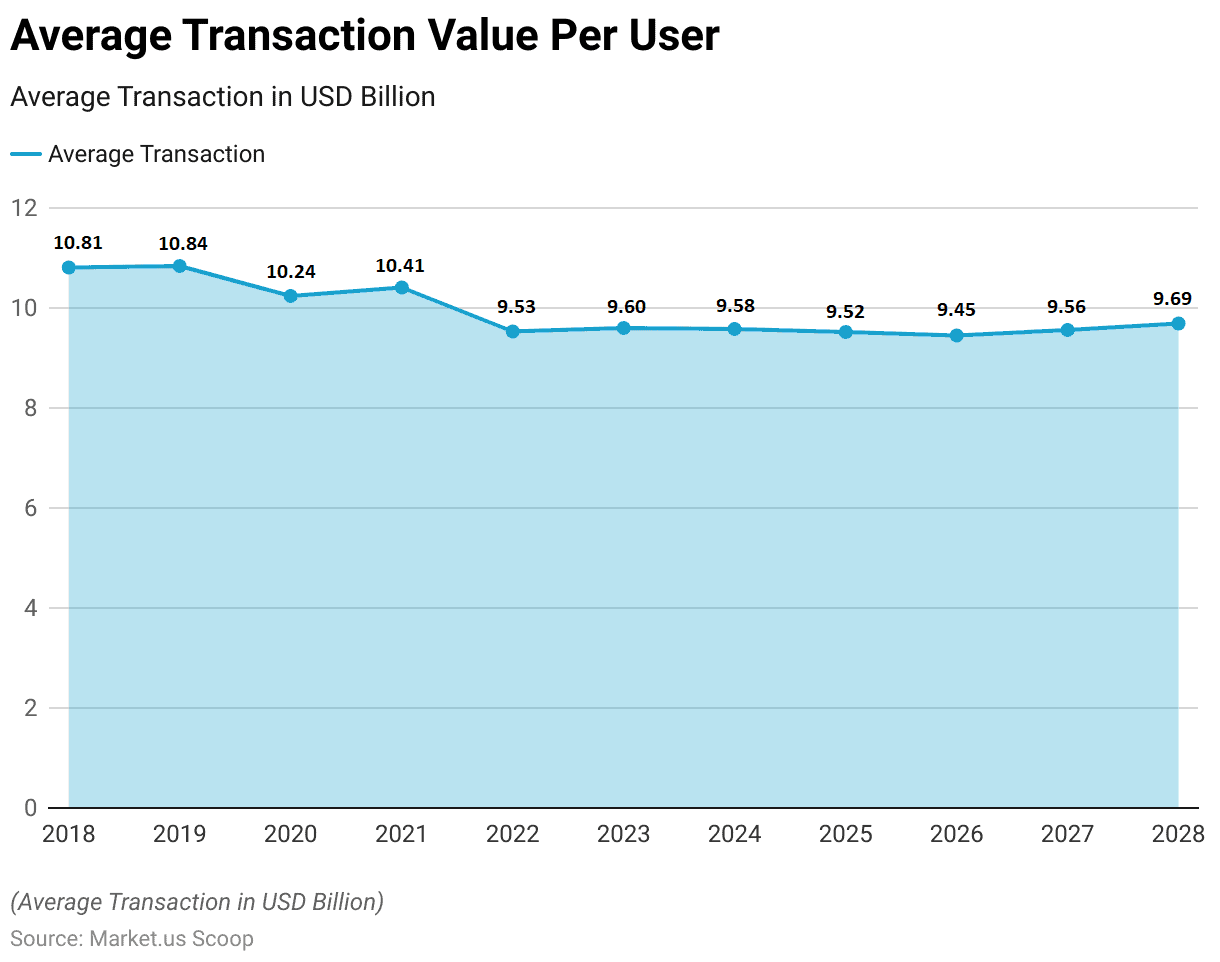
The share of digitally initiated remittances has been steadily increasing worldwide, reflecting a significant shift from traditional methods.
Take advantage of our unbeatable offer - buy now!

2018-2019
- In Q1 2018, traditionally initiated remittances dominated the market at 90.06%, while digitally initiated remittances accounted for only 6.81%, and digital end-to-end transactions were at 3.13%.
- This upward trend continued through 2019, with Q1 seeing 8.70% digitally initiated and 3.76% digital end-to-end, and Q4 reporting 10.03% and 4.13%, respectively.
2020-2021
- The trend became more pronounced in 2020, as the share of digitally initiated remittances grew to 10.70% in Q1 and 12.46% by Q4, with digital end-to-end transactions reaching 4.25% and 5.74%, respectively.
2022-2023
- By Q3 2023, these figures were at 52.89% for traditionally initiated, 28.95% for digitally initiated, and 18.10% for digital end-to-end transactions, highlighting a sustained shift towards digital remittance methods.
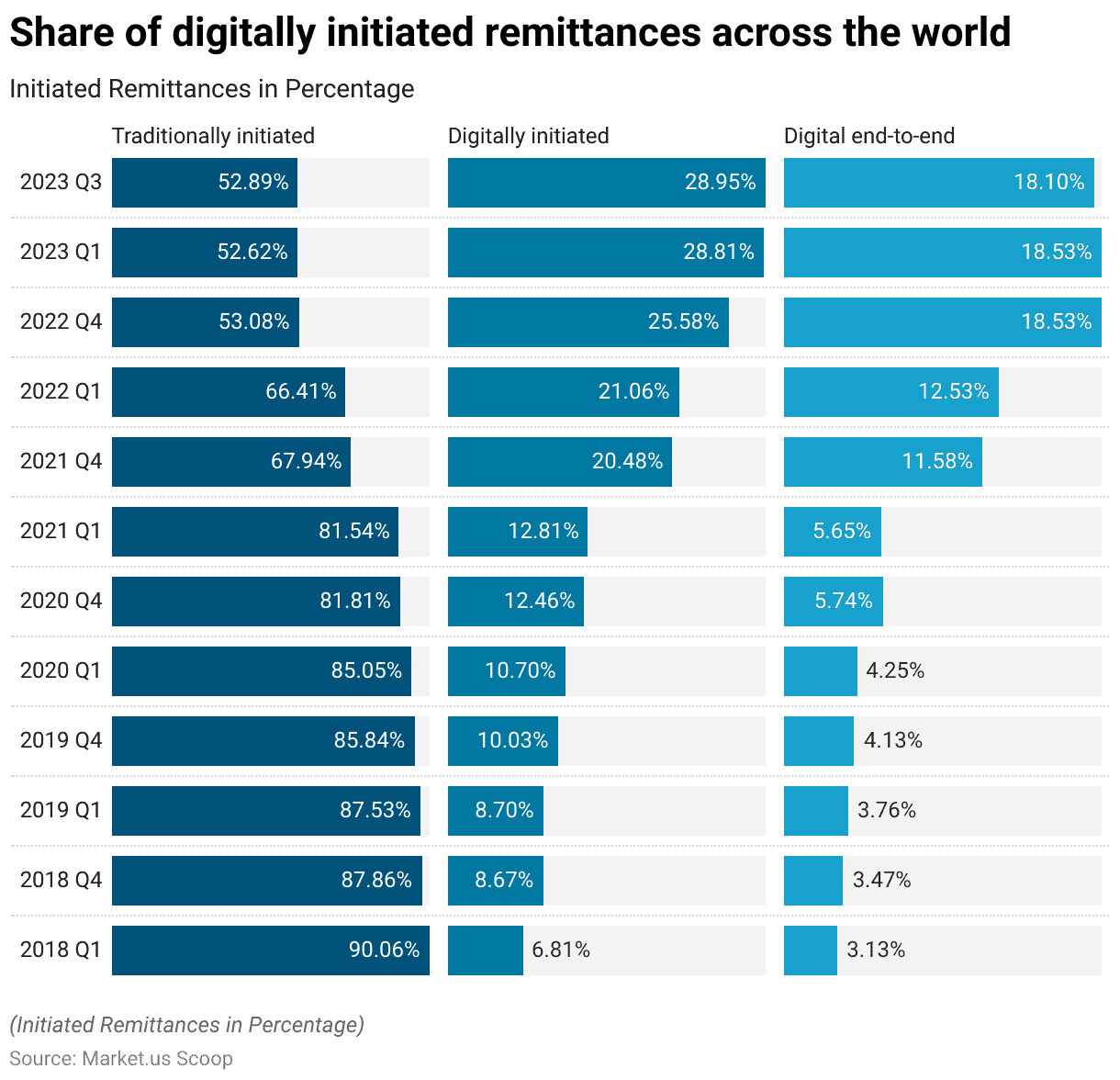
Digital Remittance Transaction Value Across Various Nations
- Several key countries significantly influence the digital remittance market, each contributing substantial transaction values.
- The United States leads the market with a digital remittance transaction value of USD 29,920 million.
- Saudi Arabia follows with USD 14,730 million, indicating a strong adoption of digital remittance services in the region.
- Switzerland and China also have high transaction values, with USD 10,850 million and USD 10,560 million, respectively.
- Germany contributes USD 9,246 million to the market, while France accounts for USD 5,109 million.
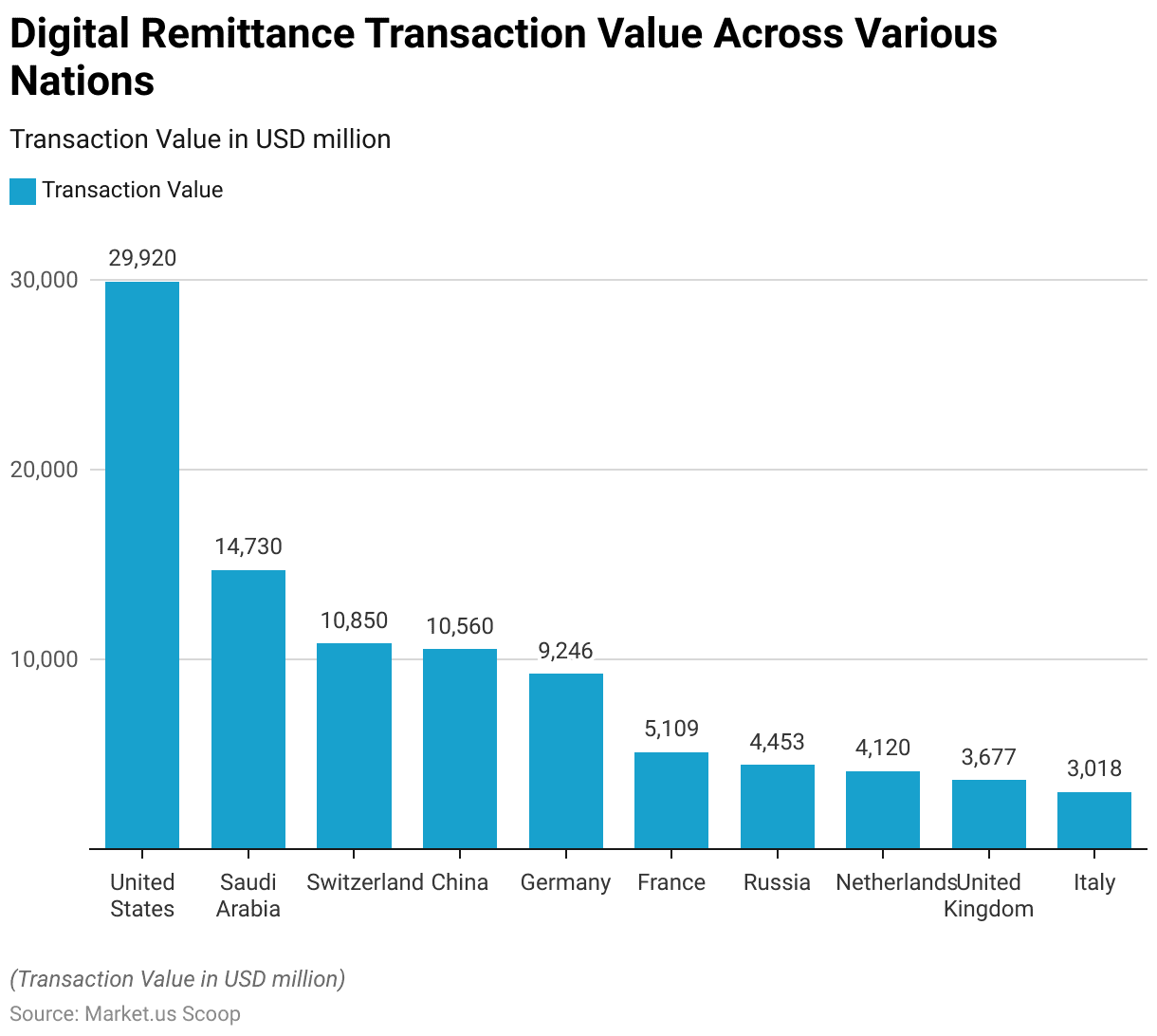
Digital Remittance Growth and Transaction Values by Region
- The adoption of digital remittance services has varied across different regions, with notable growth rates and transaction values.
- In the East Asia and Pacific region, remittance transactions grew by 2.6%, reaching a total value of USD 147 billion.
- South Asia experienced a higher growth rate of 6.1%, resulting in USD 139 billion in transaction value.
- Latin America and the Caribbean saw the most significant growth, with a 7.4% increase to USD 96 billion.
- Europe and Central Asia also showed robust growth of about 6%, achieving USD 65 billion in transactions.
- The Middle East and North Africa region grew by 2.6%, totaling USD 59 billion in remittance transactions.
- In contrast, Sub-Saharan Africa experienced a slight decline of 0.5%, with transaction values decreasing to USD 48 billion.

Adoption Trends in Digital Remittance
- A study in France and Poland found that 62% to 67% of individuals used digital devices for international P2P remittances, compared to 61% in the United States, where physical payments like cash and cheques remain common.
- According to the Visa study and ECB analysis, digital P2P payments in the Eurozone more than tripled from 2019 to 2022.
- The pandemic spurred this growth, increasing mobile app usage for P2P payments from 3% to 10% by number and from 4% to 11% by value.
- In Poland, 56% of people who previously used only physical methods for foreign P2P transfers are likely to switch to digital.
- Poland, mainly a remittance recipient, has over 21 million digital banking users, with 16.5 million using mobile apps.
Use of Digital Financial Technology During the COVID-19 Pandemic
- In 2021, the COVID-19 pandemic significantly influenced the increased use of digital financial technology across various economies, with distinct differences observed between emerging markets and developing economies versus advanced economies.
- In emerging markets and developing economies, 65% of the population reported an increased use of digital smart payments and remittances, compared to 50% in advanced economies.
- The adoption of digital banks was also higher in emerging markets, with 24% of the population reporting increased use, while in advanced economies, this figure was 18%.
- Similarly, digital savings or deposits saw a higher uptake in emerging markets at 22%, compared to 12% in advanced economies.
- Digital lending followed the same pattern, with 14% of the population in emerging markets and developing economies reporting increased use versus 12% in advanced economies.
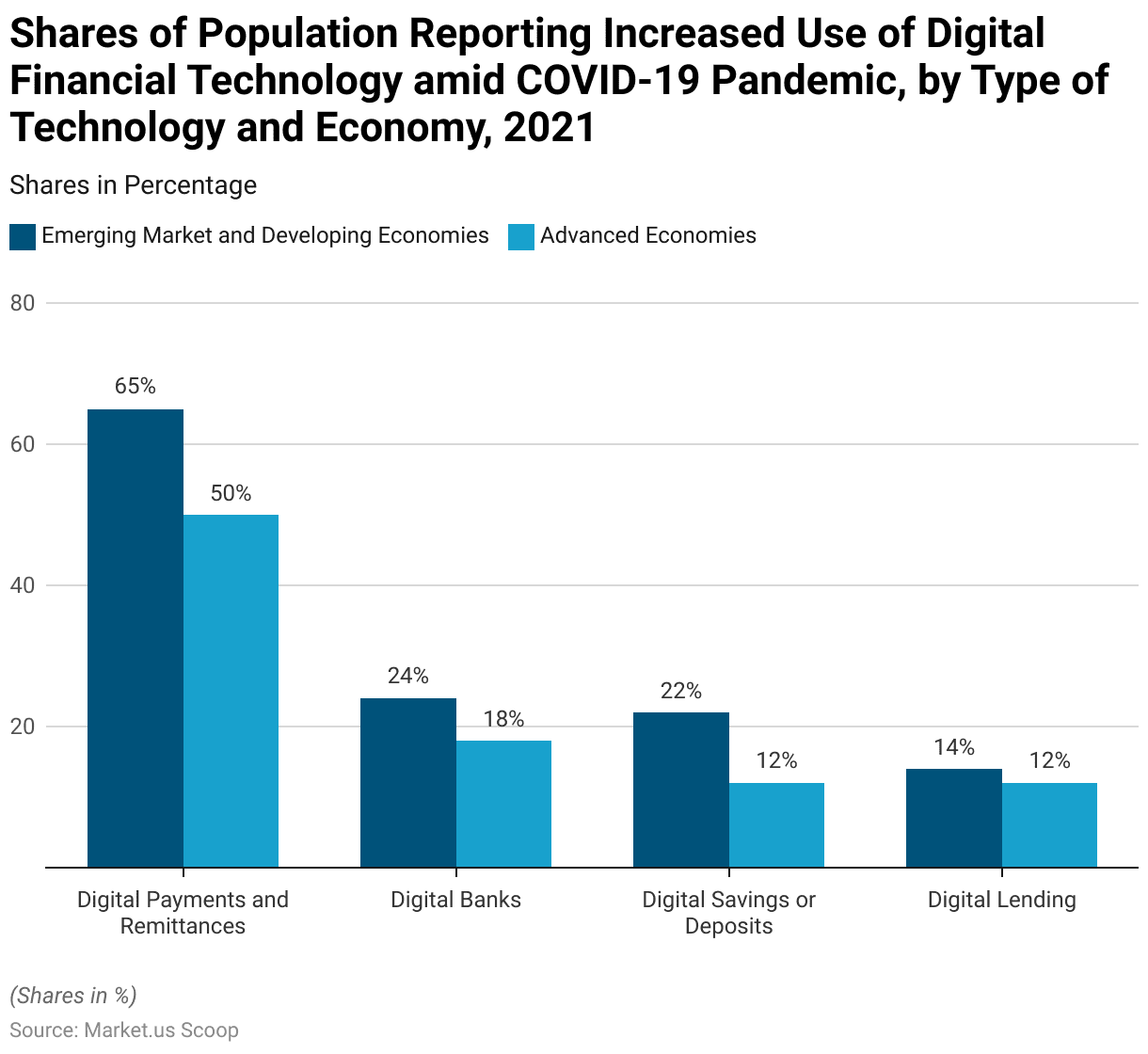
Key Challenges in Digital Remittance
- According to the World Bank, 65% of adults in developing nations lack access to essential financial services, making it challenging for them to save money, build credit, pay bills, and engage in the financial system.
- A recent survey by the International Association of Money Transfer Networks (IAMTN) and the United Nations Capital Development Fund (UNCDF) revealed that 91% of over 75 remittance service providers (RSPs) from more than 30 countries have noticed changes in remittance volumes, with the majority (69%) reporting a sudden decrease.
Discuss your needs with our analyst
Please share your requirements with more details so our analyst can check if they can solve your problem(s)



